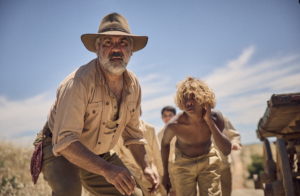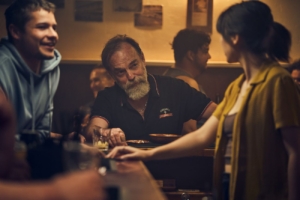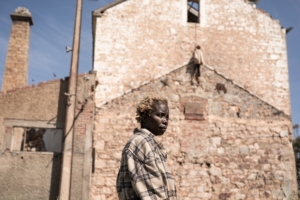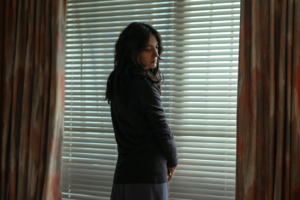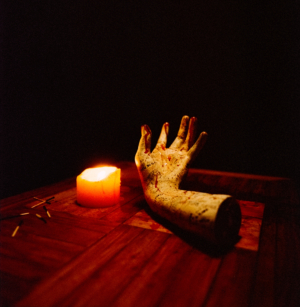The Aussie Battler
Newsreels were a dramatic presence on the Australian screen for a period of almost 70 years. The cameramen and crews who made them indelibly stamped the energy and excitement of those early years on the annals of our history. Captivating audiences with their high-paced, distinctive coverage of local and national events, the weekly newsreels were seen throughout the world and translated into eight languages. They became the mass medium of the era, and a form of communication unparalleled for its dynamism and impact. Every Saturday the newsreels were enthusiastically awaited by Australian cinema goers.
Through its combination of documentary and fictional footage, Newsfront creates the texture of Australian life between World War II and the dawning of the Space Age. It charts the decline with the advent of television of the all-Australian newsreel company, Cinetone.
Newsfront is the story of the men who made the newsreels. It is an authentic recreation of the years from 1948 to 1956 in Australia, which frame the lives of cameraman Len Maguire, his brother Frank, his wife, Fay, and Amy — a woman working with the Cinetone team in a man’s world. It is a chronicle of an emerging society showing how the years of expansion affected the attitudes and values of a group of people vitally involved with its growth.
The film opens with newsreel footage showing Chico Marx entertaining a group of uniformed men playing his version of “Waltzing Matilda”. The date and place is rapidly established in the titles. It is Sydney, Australia, 1948. The mood is goodnatured as the clip demonstrates the interaction of two cultures, the American and the Australian. The following segments from the newsreel reveal a montage of ghostly images from the past, and a context of change which is a prelude to the narrative of the film. Continuing the economic and dramatic style of the documentary footage, introductory shots of its characters linked by a sequence of wipes define them in relation to their work and each other.
Historically Newsfront is important for two reasons. Firstly, it depicts the major political and social events happening in Australia during the post-war years. Secondly, it documents the demise of the film industry of the time. Len Maguire is the central character of the film’s narrative. He represents the image of the “Aussie battler”: hardworking, reliable, responsible, honest and suspicious of change. As a newsreel cameraman he is constantly in contact with the harsh, physical elements of the country as well as the political beliefs and social mores of the time. He is doggedly loyal to the Cinetone company but his brother Frank tells him he is a “company hack”. Unable to verbalise his beliefs and feelings, Len is more at home behind the camera. His response to Frank’s statement is typically brief and explicit. Unlike Len, Frank “moves with the times” and is willing to sell his beliefs for monetary gain and power. Frank admits making an anti-communist film which will further the right-wing cause of the Liberal government. Len is annoyed at Frank’s sell-out to the Right when he is supposedly a Labor voter. Frank justifies his actions by replying that he is merely doing his job. Eventually he defects to America lured by the more lucrative industry overseas. The tense relationship between the two brothers illustrates the wider tensions in Australian society at that time.
The use of the actual newsreel footage graphically recreates the events leading up to Prime Minister Menzies calling the referendum enabling the government to outlaw communism. The belief in a democratic system of government turns to paranoia. The work demanded by the Cinetone company comes in conflict with the political beliefs and ideologies of some of the crew, making them sensitive to the dangers of pronouncing judgement on the actions of the government.
Len’s resistance to change is contrasted by Menzies’ strengthening the ties with America and the influx of one million migrants into Australia by 1956. Resistance to change is also seen in the newsreel industry. The film world is feeling the effects of the powerful overseas companies. A.G. decides to concentrate Cinetone’s coverage on the familiar aspects of Australian rural life. His attempt to represent the “true Australian” of the outback was naive and lacking in insight because the nation was rapidly becoming an urban and multi-cultural society.
The conflicts of the era are captured in a dramatic scene in the Cinetone production room. A facile story on a singing dog gives way to a Press Conference where Mr Menzies outlines his government’s decision to suppress the Communist Party. In the sound recording booth, Ken reads the voice over: ‘Undaunted, the P.M. has recently called for a constitutional amendment enabling the government to outlaw Communism … This, in Dr Evatt’s view, will give the minister’s Police State powers’. Ken blanches. He refuses to read the strongly worded comments of Dr. Evatt. Fearful for his job, and aware of the dangers of pronouncing judgement on the government, he nevertheless agrees with Geoff s jibe that: ‘Any government which won’t let you say anything against it is a police state government.’ But he lays his job on the line rather than read the offending passage.
This tense sequence, bristling with carefully composed medium shots seems to heighten our growing sense that the newsreel is a medium of great power over its audience. Its effectiveness is made explicit by the confrontation it provokes between the men who produce it.
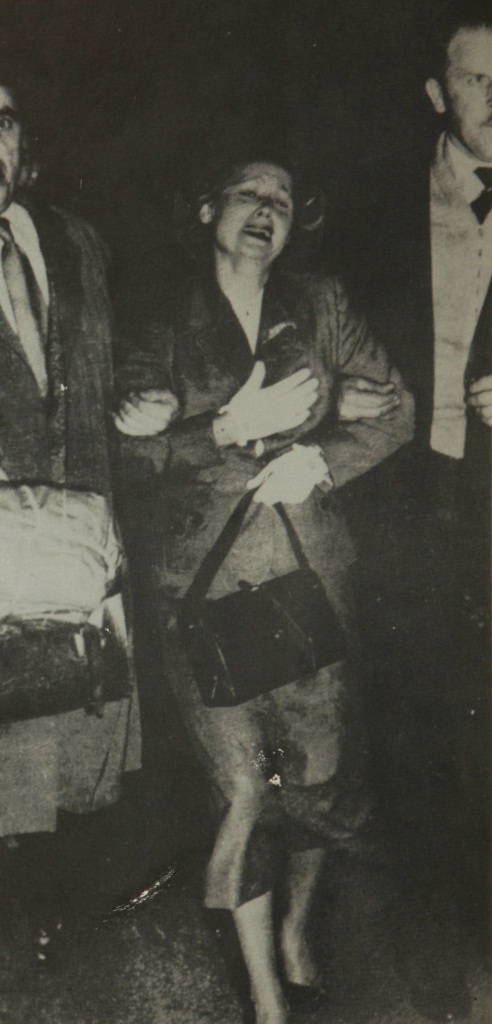
As the film moves into the Spring of 1951, personal relationships are again to the fore. A baby photograph introduces the next chapter of the narrative which deals with the conflicts of Len’s marriage. The baby photograph is a record of the private history of an Australian family, and at the same time a symbol of one of the preoccupations of the Fifties generation. Their attitude to family life reflected the essential innocence and optimism of the times. The post-war baby boom was a response to the new affluence of a country unravaged by wars, and was considered a patriotic investment in the future of Australia. “Populate or perish” was one of the popular slogans of the era. But in the character of Fay, Len’s wife, the film reflects on the sheltered domesticity that was a central feature of the life of a typical Australian woman. A devout, capable mother, Fay is caught in a cycle of pregnancies endorsed by the times. Frustrated by her isolation and loneliness, she is openly hostile to Len. Her unswerving adherence to Catholic beliefs results in her retreat from the sexual aspects of their marriage. Len’s political sympathies differ from the pronouncements of her church, and this is a further source of embarrassment to both Fay, and her family. Stubbornly defending his right to vote Labor against the referendum to outlaw communism, Len is a scandal at the new baby’s baptism. His cursory treatment of the parish priest in this scene causes an irreconcilable rift between himself and Fay.
Amy, on the other hand is a working single woman in a man’s world. A long time girlfriend of Len’s brother Frank, she is an awkward presence for the more conventional women with whom she is acquainted. Competent, career-oriented and single, Amy’s significance in the film derives from her unacceptability in the context of the fifties conservatism. Her unmarried status is a constant irritation to Len also, who constantly badgers Frank to settle down with her. The division between the sexes is clearly defined in the film. The characters are identified functionally and simply — the men with their work, and the women in relation to their marital status, their children and their domestic duties. It is the classic dichotomy of the Australia sexes in the fifties.
The dream of the fifties girl was to get married: a point neatly established in the film when the Cinetone receptionist is seen filing her nails whilst she listens to an episode of the radio serial When A Girl Marries. The film’s study of the sentimental and headlong approach to love and marriage in the post-war years reveals one facet of society’s changing attitudes during this period of time. Len eventually bypasses his moralistic approach to life and enters into an illicit relationship with Amy, whilst his ex-wife will remarry, thereby flouting the principles of her religion and demonstrating an independence of mind unthinkable for her as a young Catholic wife.
The style of the film is both personal and affectionate. The characters are presented in clean-cut images that stress the basic thrust of their personalities and their values. The camera comes in close to their lives, often ironically demonstrating the restrictions and limitations of their environment and their attitudes in the many medium shots of the script. The narrative focuses on the central characters in predominantly urban settings, in the confined space of cars, offices, the studio, and the small rooms of flats and houses. The nature and scope of Australia, the “Big Country”, is created by the newsreel footage, and by the action sequences of the Redex Trial and the Maitland floods. The film is a chronicle of private and public life, punctuated by narrative and transitional devices, such as the old-fashion wipes indicating the march of time. The essential optimism of Newsfront is captured in its closing images. A colour shot of Len is superimposed over the final montage. He represents the spiritual legacy of the nation. Newsfront is a celebration of this legacy.

Workbook
1. The film shows typical images of the fifties. Describe two of these, and explain their significance in the film.
2. How does the film establish the relationship between the main characters and their work? How do we see the other characters in the film?
3. Describe a scene from Newsfront which captures an authentic sense of Australia. Describe how the scene achieves this effect.
4. What is distinctive about the newsreels? Would they appeal to modern audiences? Why does Cinetone want to remain “purely” Australian? Should Australians support the Australian film industry? What are the problems of the Australian film industry?
5. How are the newsreels used in the story of Newsfront? How effectively do they blend with the narrative? Describe one sequence where this is done. Is it always possible to tell the difference between the documentary footage and the new footage of the film?
6. Newsfront gives us a number of perspectives on the events and attitudes of the years from 1948 to 1956. How is this done in the film? Describe a scene where this occurs. What is the perspective of the film in this scene?
7. What is Newsfront‘s perspective on the era it examines? How do we know the film’s final perspective?
8. What image of Australia is revealed by the early newsreels? Which facets of Australian life does the first montage emphasise?
9. What devices does the film use to suggest the passing of time? How are these devices used in the film? What is their effect?
10. Why does the film have some sequences in black and white, and others in colour? What is your opinion of this mixture of footage?
11. “Waltzing Matilda” is played at the beginning of the film, and at the end “The Road to Gundagai”. How do the two songs differ in style and rhythm? Is there a reason for this difference? Why do you think these two songs are used in the film?
12. Describe a scene in the film where we can hear an American pop song of the period playing in the background. What effect is achieved by the pop music in the scene? How is the pop music of the early fifties different from contemporary pop music? Can you think of any reasons for this difference? Why was rock and roll music considered revolutionary in the fifties? Why do you think rock music has continued to be so popular over the years? Can you name any of the rock idols of the fifties? How many of them are Australian?
13. How would you describe the music that opens the old newsreels? Is it like other music in Newsfront? What is the effect of the music in Newsfront?
14. Newsfront uses many medium and close shots of its characters. What is the purpose of these kinds of shots? Do any characters in the story discuss types of shots and their intention?
15. Why does the advent of T.V. in Australia mean the decline of the newsreel industry? How does the film demonstrate this point? How is T.V. different from film? What advantages does a film have that T.V. does not?
16. Australia is predominantly a nation of city dwellers. How is this conveyed by the film? How does the film manage to suggest the size and scope of Australia despite this?
17. How does the film show the progressive influence of America in Australian society? Describe one scene in the film where this is made explicit.
18. Why is a colour image of Len superimposed upon the final montage of the film? What is the purpose of the final montage?

